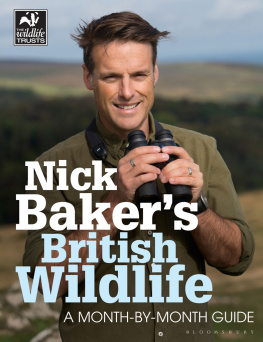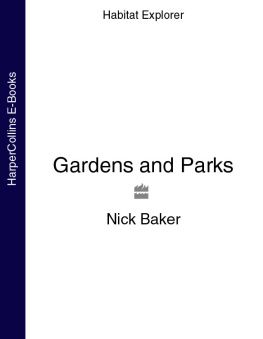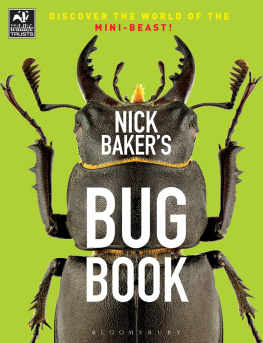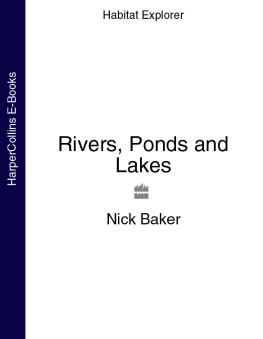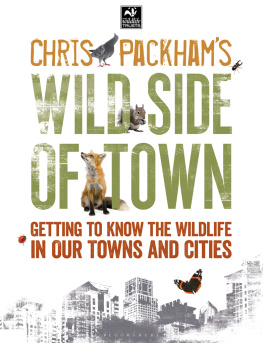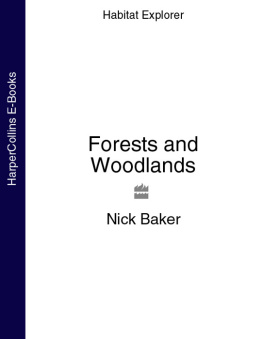First published in 2003 by New Holland (UK) Ltd
50 Bedford Square, London WC1B 3DP
This electronic edition published in 2015 by Bloomsbury Publishing Plc
Copyright 2015 text by Nick Baker
Copyright 2015 photographs as credited below and
The moral right of Nick Baker has been asserted.
All rights reserved
You may not copy, distribute, transmit, reproduce or otherwise make available this publication (or any part of it) in any form, or by any means (including without limitation electronic, digital, optical, mechanical, photocopying, printing, recording or otherwise), without the prior written permission of the publisher. Any person who does any unauthorised act in relation to this publication may be liable to criminal prosecution and civil claims for damages.
Every reasonable effort has been made to trace copyright holders of material reproduced in this book, but if any have been inadvertently overlooked the publishers would be glad to hear from them. or legal purposes the constitute as an extension of the copyright page.
Bloomsbury Publishing Plc
50 Bedford Square
London
WC1B 3DP
www.bloomsbury.com
Bloomsbury is a trademark of Bloomsbury Publishing Plc
A CIP catalogue record for this book is available from the British Library
ISBN (print) 978-1-4729-1205-3
ISBN (ePub) 978-1-4729-2160-4
ISBN (ePDF) 978-1-4729-2161-1
Front cover: Tony Cobley Photography, www.tonycobley.com
To find out more about our authors and books visit www.bloomsbury.com. Here you will find extracts, author interviews, details of forthcoming events and the option to sign up for our newsletters.

Contents

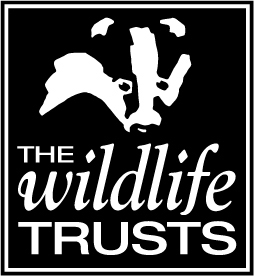
The Wildlife Trusts
The Wildlife Trusts are the UKs largest people-powered organisation caring for all nature rivers, bogs, meadows, forests, seas and much more. We are 47 Wildlife Trusts covering the whole of the UK with a shared mission to restore nature everywhere we can and to inspire people to value and take action for nature for future generations.
Together we care for thousands of wild places that are great for both people and wildlife. These include more than 760 woodlands, 500 grasslands and even 11 gardens. On average youre never more than 17 miles away from your nearest Wildlife Trust nature reserve, and most people have one within 3 miles of their home. To find your nearest reserve, visit wildlifetrusts.org/reserves , or download our free Nature Finder iPhone app from the iTunes store. You can also find out about the thousands of events and activities taking place across the UK from bug hunts and wildplay clubs to guided walks and identification courses on the app or at wildlifetrusts.org/whats-on
We work to connect children with nature through our inspiring education programmes and protect wild places where children can spend long days of discovery. We want children to go home with leaves in their hair, mud on their hands and a little bit of nature in their heart. Find out more about our junior membership branch Wildlife Watch and the activities, family events and kids clubs you can get involved with at wildlifewatch.org.uk
Our goal is natures recovery on land and at sea. To achieve this we rely on the vital support of our 800,000 members, 40,000 volunteers, donors, corporate supporters and funders. To find the Wildlife Trust that means most to you and lend your support, visit wildlifetrusts.org/your-local-trust
The Wildlife Trusts
The Kiln, Mather Road, Newark, Nottinghamshire
NG24 1WT
t: 01636 677711
e:
Registered Charity No 207238
wildlifetrusts.org
Find us on
Twitter @wildlifetrusts
Facebook facebook.com/wildlifetrusts
Introduction
Be aware that the topic I have tried to tackle in this book wildlife in Britain and Ireland is so vast and varied that, although it is a subject that I love and that has been a huge part of my life, my knowledge is riddled with many holes, especially in the world of those largely green denizens of the world the plants! For any limitations in this area, or for any potential shortcomings of expectation, I apologize wholeheartedly.
This book certainly isnt intended to be a field guide to everything that walks, swims, flies or photosynthesizes here in the UK. Nor is it intended to be a simple coffee table book that sits on a shelf, unread, unloved and unwanted (why on Earth they are called coffee table books I dont know, they rarely ever spend much time there). My own coffee table is frequented by books I like, so having said that I guess I do want it to be a coffee table book after all!
I hope that this book will inspire anyone who reads it to look out of their windows, windscreens and binoculars in a different way and see things they have never seen before. After all, we live in a country that despite seeming sterile and grey at times, is actually far from it. Knowing where to look at what time is the secret to its beauty.
That being said, I do not wish to spell out every experience! (There is nothing worse or more patronizing than an idiots guide to the world, complete with glaring signposts.) I want merely to start the ball rolling in the right direction for maximum enjoyment and future inspirations.
For example, just getting the timing right can make all the difference. A visit to a mud flat during an hour or so either side of high tide can turn the first timer into a wader watcher for life, just by delivering all the best features up close and in their full gorgeous glory, doing all those interesting things that the field guides tell you about! Get it wrong, and all the enthusiastic amateur will see will be a few unidentifiable, animated specks in the distance. The disappointed may well turn to other pursuits and for the rest of their days believe that watching omnibus editions of EastEnders or even macram are more stimulating ways to pass a wintry Sunday afternoon (take it from me, they arent, Ive tried both and they simply dont work!).

Rockpooling and beachcombing Catch the tide when it is high and who knows what extraordinary creatures you may find in your net. Wildlife watching with friends is double the fun and they can help you carry any equipment you may need, as well as other necessities lunch!
Part of the magic of wildlife for me is its unnerving ability to surprise you. Just when you think you have seen, heard and smelt everything about a place, something rocks up and knocks your socks off.
Tidal pools are just one such place that continue to surprise me. Ive been turning rocks over ever since Ive owned my own bucket and spade, in fact I feel like Ive looked under every rock from Bangor to Bognor. Despite this, just the other day I was startled to find under a particularly unassuming rock in Torbay at least two of the funkiest little beasts that I had ever set my eyes on a turquoise flat worm, straight out of Jimmy Hendrix land, and a white and orange sea slug, with all the grace and flounce of a 1930s ladys boa!
To sum up, the message behind this book is simply Get out there! Wake up, smell the Primroses, fresh mown grass, guano, whatever, just do it!
FIELD ETIQUETTE AND THE RULES OF RAMBLING

